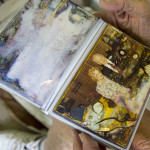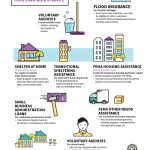BATON ROUGE, La. — If your house flooded and you did not have flood insurance, you may have received some federal financial assistance for the August flooding. But if your home is in a floodplain and you hold a mortgage from a federally regulated or insured lender, you may be required to buy flood insurance.
This requirement applies when a building has been damaged and is located in an area that is at high risk of flooding. These high-risk areas are called Special Flood Hazard Areas (SFHAs).
In high-risk areas, there is at least a one in four chance of flooding during a 30-year mortgage. You may be restricted to only rental assistance in a future disaster unless you buy flood insurance and keep the policy in effect.
A flood-insurance policy protects you financially even when a presidential disaster is not declared or if you live in a parish that was not designated for federal assistance.
Once you receive federal financial assistance, you must keep flood insurance coverage at your address even if the damaged building is replaced by a new one. If you sell your home, you are required to inform the new owners that they must maintain flood insurance coverage on the building. Often, an existing flood-insurance policy can be transferred to a new owner with no lapse in coverage.
You may receive a Certificate of Flood Insurance for a Group Policy as a part of your federal Individuals and Households Assistance program (IHP) grant. This policy provides minimal coverage on the home equal to the maximum IHP grant currently available. For the Louisiana August 2016 floods, the required premium provides coverage of $33,000.
- Group Policies have a term of three years, after which you will be required to purchase and maintain a Standard Flood Insurance Policy through the National Flood Insurance Program (NFIP) until you are no longer the homeowner or renter at that location. In order to avoid any lapse in coverage, it is important to apply for your new coverage at least 30 days before the expiration of the Group Policy.
- You may cancel your participation in the Group Policy at any time during its policy term, provided that you have purchased your own NFIP flood insurance coverage.
If you are a renter and receive federal financial assistance, flood-insurance coverage must be maintained on the contents for as long as you live at the flood-damaged rental property. The requirement for flood insurance is lifted once you move from the building.
But, because federal law mandates the purchase of flood insurance as a condition of disaster funding, an applicant who does not comply with the flood insurance obligation may become mostly ineligible for future disaster assistance. It’s that important.
If you do not live in a flood zone but your home was flooded, you do not have to maintain flood insurance. Even without the legal requirement, it is a wise decision to purchase flood insurance.
Even though flood insurance isn’t federally required in moderate- to low-risk areas, homeowners and businesses that have mortgages from federally regulated or insured lenders may be required to purchase flood coverage by the mortgage holder. Anyone can be financially vulnerable to floods.
In fact, people outside of mapped high-risk flood areas file more than 20 percent of all National Flood Insurance Program flood-insurance claims and receive one-third of federal disaster assistance for flooding. When it’s available, disaster assistance is typically a loan you must repay with interest.
With all that you are going through, don’t let this vital coverage slip through the cracks. Protect yourself and your family from future financial loss by purchasing and maintaining flood insurance coverage.
For more information about the NFIP and flood insurance, call 800-427-4661 or contact your insurance company or agent.
###







